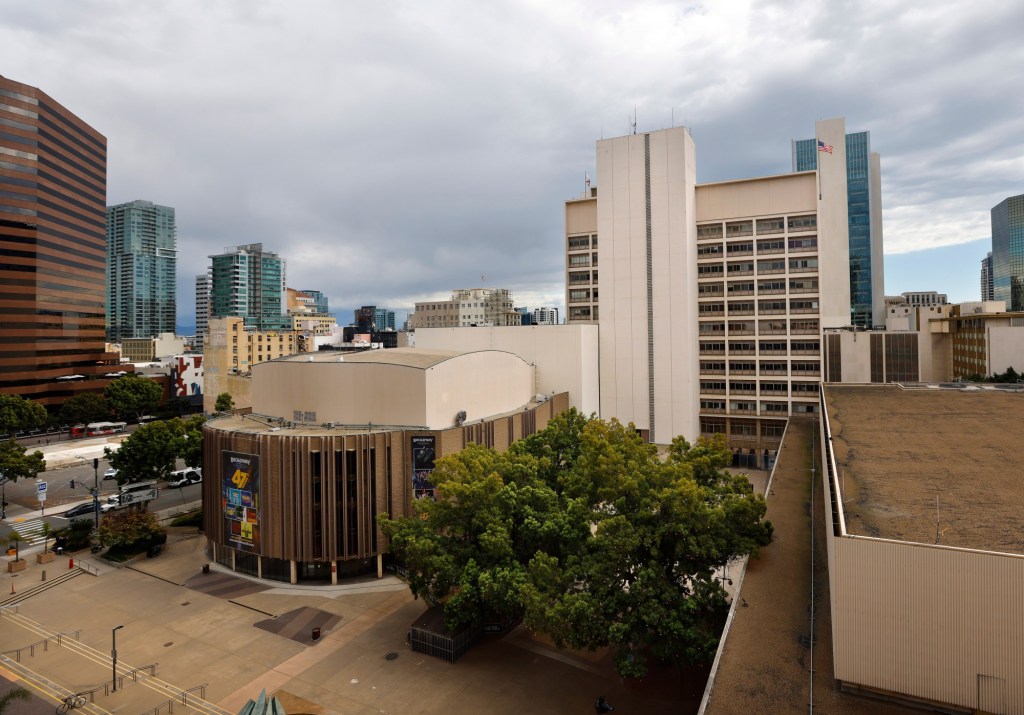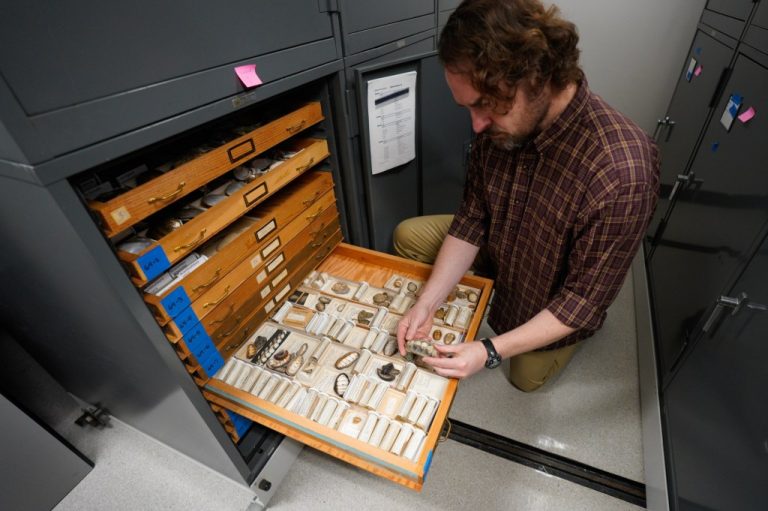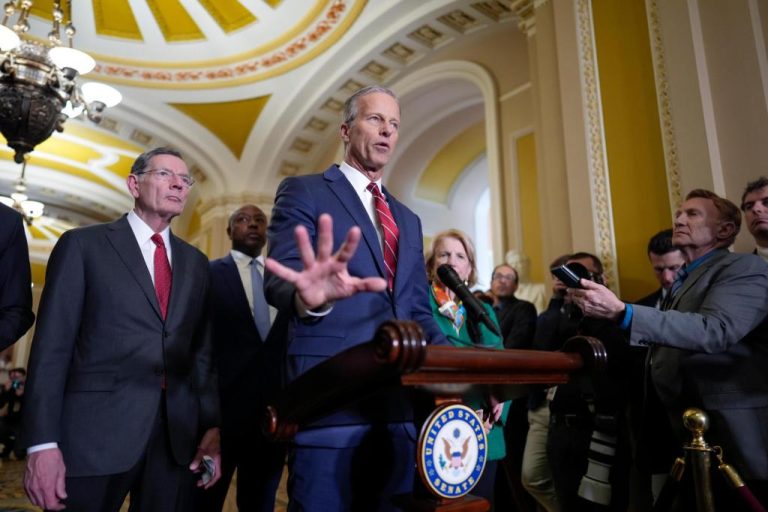

San Diego Mayor Todd Gloria has abandoned his ambitious plan to offer the city’s downtown real estate for redevelopment as part of an effort to secure a new City Hall facility for government workers.
The decision, announced Wednesday as part of package of potential emergency budget cuts, comes after voters last month rejected a sales tax hike that would have helped offset projected budget deficits of nearly $1.5 billion over the next five years.
The Civic Center Revitalization effort, as the plan is called, was envisioned by Gloria in 2022 as a way to bring new life — and potentially thousands of residential units — to the aging Civic Center complex in the heart of downtown San Diego.
The idea was to lease or sell the city’s municipal real estate to fund the construction or purchase of a brand-new City Hall facility.
The plan was heralded by Gloria, at the time, as a solution to a problem that has plagued the city since the late 1980s, when officials were confronted with major maintenance needs at City Hall and considered acquiring land in East Village for replacement office space.
The latest effort, which has advanced in fits and spurts, is now dead.
“The vision of building a new City Hall or acquiring a new building to relocate city operations into is not going to be happening — at least for the foreseeable future,” Gloria told the Union-Tribune. “We’re going to be faced with a number of very difficult choices in order to address the structural deficit that we’re dealing with. And this is one of those. But this is one of the (choices) that we have total control over.”
The decision means all work on the project will stop, including the work of a city consultant hired to help evaluate options for a new City Hall.
The city will also attempt to renegotiate or terminate office leases elsewhere downtown that are paid for by the general fund. And it will seek to move more of its downtown workforce back into a dying complex that Gloria will try to keep on life support.
“If we own it, we should be using it,” Gloria said. “I’ve worked for the city since 2008 and I’m intimately familiar with the shortcomings of the facilities that we have, and those continue to be the case. My job is to make sure that we’re running the city for the benefit of the people. The priority is making sure that when citizens call 911 we have someone to respond to them, and that we continue to address homelessness.”
The Civic Center complex is bounded by A Street and C Street to the north and south, and First Avenue and Third Avenue to the east and west. The four-block area features the City Administration Building (aka City Hall), which was built in 1965 and is home to the mayor’s office, city clerk’s office, council member offices and council chambers. The quad also includes the Civic Center Plaza office tower, Golden Hall, a public plaza, a parking garage and the 3,000-seat Civic Theatre.
The city’s real estate holdings extend across the street to a fifth block at 1222 First Ave., which is home to the City Operations Building (or COB). The city also owns the adjacent block at 101 Ash St.
In September 2022, the mayor formed the Civic Core Revitalization Citizen’s Committee, marking the formal start of his push to offload the land in pursuit of something better.
In May 2023, San Diego offered five of the six blocks for sale or lease, following the requirements spelled out in California’s updated Surplus Land Act. However, the Civic Center Revitalization solicitation failed for the most part to attract developer interest.
The lack of interest in the urban real estate was attributed to the onus placed on prospective developers by the Surplus Land Act, which prioritizes the production of subsidized housing for low-income families. At a minimum, developers were required to set aside 25 percent of proposed residential units as affordable units, meaning deed-restricted for families making 80 percent or less of the area median income.
The city initially intended to put some or all of the blocks back on the market through a more traditional request-for-proposal process with a reduced affordable housing requirement. But the action has been on hold pending the outcome of consultant work and decisions related to 101 Ash.
At the beginning of the year, the city hired Canadian firm P3 Advisors to evaluate whether it should build its own skyscraper or acquire an existing property. The contract was funded with $2 million in general fund money, allocated by council members in 2023, although it’s unclear how much has been spent to date. The firm’s analysis has yet to be completed and it will be left unfinished.
The finished product was going to be a recommendation on City Hall, said Jay Goldstone, a special adviser to the mayor who was been leading the Civic Center Revitalization effort for the city.
The build-or-buy analysis will likely be outdated if the city resumes its pursuit of new facilities, he said.
“There are some opportunities out there today that most likely would not be available a year or two from now,” Goldstone said, referring to downtown properties that the city could potentially acquire at a steep discount given market conditions.
Properties that have been considered as potential City Hall replacements include two office buildings at Stockdale Capital Partners’ Campus at Horton project, the 17-story tower at IQHQ’s Research and Development District on the waterfront, and Irvine Company’s Wells Fargo Plaza.
Although downtown office buildings are trading for cheap, the city has not been offered similarly attractive terms, Gloria said.
“A lot of these folks, when they see the city walk in the room, they’re not giving us the smoking-hot deals that they’re offering other people. It’s precisely for that reason that I will refuse to ask our taxpayers to bail out other companies for their real estate situations,” he said. “Some of these folks may regret not engaging with us more productively. But, in some ways, maybe that’s a blessing, because, again, we can take the savings from these leases and help put them toward different services as opposed to a mortgage on a building.”
In a separate-but-related effort, the city also hired in late 2022 real estate investment management and services firm Jones Lang LaSalle to assess its downtown office needs, with the work meant, in part, to help the city understand how much space would be required in a new City Hall facility. The consultant agreement was budgeted at $725,000. The firm found that the city could house 3,060 workers in 580,000 square feet of net usable space, reducing its total office footprint downtown by 239,000 square feet.
More recently, the Prebys Foundation, with the intent of preserving the Civic Theatre, hired Philadelphia-based real estate consulting and urban planning firm U3 Advisors to come up with a big-picture vision for the Civic Center blocks.
The firm’s vision document has not been completed. The U3 Advisors work will carry on, Crystal Page, a spokesperson for the Prebys Foundation, said.
“We continue to believe this project is vital for the future of our downtown and local economy as a revenue-generating project for the city, San Diegans and the region,” Betsy Brennan, CEO of the Downtown San Diego Partnership, and Grant Oliphant, Prebys Foundation CEO, said in a joint statement. “We remain firmly committed to the long-term vision of a downtown Civic Center that is a thriving hub rich in arts, culture and housing. San Diego deserves nothing less.”
The mayor said he was appreciative of the Prebys Foundation’s efforts and hopes the visioning work can be applied in some fashion in the future.
With the city staying put for some time, Gloria said he will turn his attention to finding ways to make use of Civic Center’s dead space, which includes Golden Hall. The one-time event venue was most recently used as a homeless shelter. Going forward, Golden Hall could be used for city storage or employee work space, or it could be rented out for community events or services, he said.
The mayor also wants to improve building security at City Hall and Civic Center Plaza, as well as juice revenue from the parking garage, and reopen the shuttered deli and restaurant.
As for the arguably obsolete City Operations Building, the city intends to move workers out of the building in early 2025 and into newly leased space downtown and in Mission Valley. The new leases do not come at the expense of the general fund. They are paid for using the Development Services Department’s enterprise fund, which collects fees charged for city services.
It’s unclear what will happen with the COB building after it’s completely vacated. Gloria left the door open to seek redevelopment bids for the single block at some later date.
The city is also entertaining two proposals to convert the asbestos-ridden 101 Ash St. tower into residential units for low- or extremely low-income families. Goldstone expects to return to City Council in closed session early next year with a recommendation to move forward with one of the proposals.





